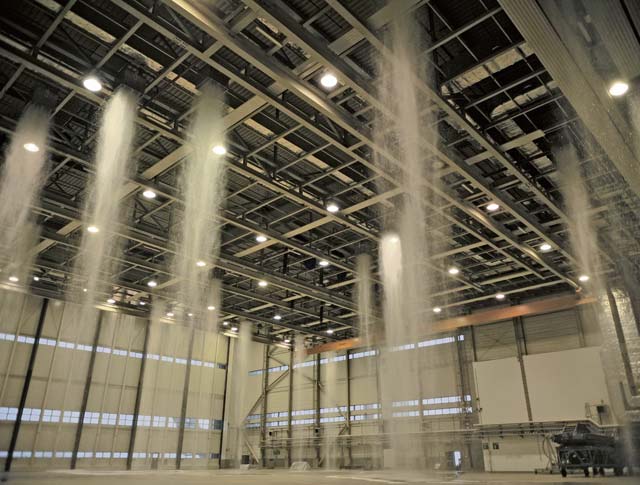
Recently, hangar five suspended operations for two consecutive days due to a biennial fire suppression system test and inspection.
Underneath the hangar floor lie two 150-cubic-meter storage tanks filled with water to be pumped through pipes and out of foam generators located in the ceiling of the hangar in the event of an aircraft fire. These tanks were emptied to test the system.
Each storage tank takes approximately 26 minutes to empty and drain back through the piping system beneath the floor. Once the storage tanks are empty, Airmen from the 786th Civil Engineer Squadron clean and inspect the large reservoirs.
“We had about 4,500 gallons of water coming out per minute from a 40,000 gallon tank,” said Airman 1st Class Thomas Gordon, 786th CES water and fuel systems maintainer. “It takes us several hours to clean and inspect each tank. We pressure wash the walls and inspect for any cracks or damage to the structure.”
Gordon said it’s a two-day process because they follow a checklist for each tank to ensure safety, compliance and effectiveness.
Not only is the test crucial for ensuring the system is constantly working, but Senior Master Sgt. Brian Eshleman, 721st Aircraft Maintenance Squadron maintenance superintendent, said it’s also good for rapport with the public.
“It’s important for us to do this test to know the facility is running properly and environmentally,” Eshleman said. “We’re doing everything we can to prevent pollution that could possibly spill into this hangar, exit the facility and enter the environment. We want to give the German community the confidence that we’re doing everything we can do to ensure their landscape stays intact and healthy.”
Staff Sgt. Benjamin Schultz, 786th CES water and fuel systems maintainer, said the hangar is designed to control pollution through an underground network of storage that collects the water and is released into a sanitary sewer in controlled amounts and regulated by a sewage treatment plant in Landstuhl.
The hangar is unique because it’s the only one in U.S. Air Forces in Europe and Air Forces Africa with the capability to support aircraft coming and going with different amenities.
The hangar can service various aircraft, including the C-5, C-17, KC-135, KC-10 and C-130, as well as several commercial aircraft.
“This hangar supports five combatant commands,” Eshleman said. “The hangar is the only certified internal fuel tank system repair facility in Europe that can fully enclose a C-5 or C-17 for internal fuel systems maintenance, engine changes and flight control surface changes.”
With inspections happening twice a year, the 721st AMXS and 786th CES Airmen continue to work together to ensure fire safety and sanitation remain a priority to warrant a successful mission.







